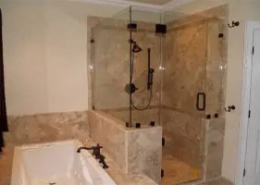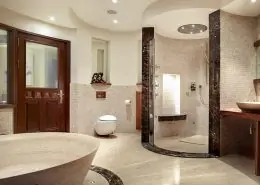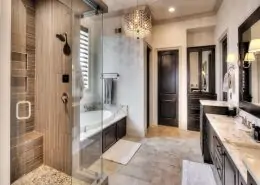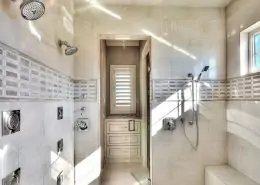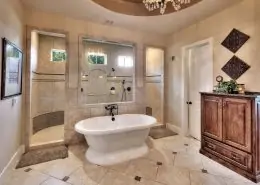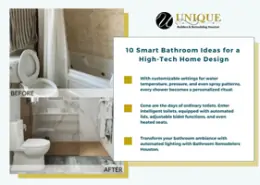Transforming Your Bathroom: What a Wet Room Can Do
Tags
Wet Room Bathrooms | Wet Room Bathroom Design | Wet Room Ideas
When it comes to bathroom remodeling in Houston, homeowners frequently look for creative methods to maximize space, create a more efficient layout, and improve the overall aesthetics of their bathrooms. Adding a wet room is one innovative option that can transform both the functionality and style of your bathroom.
The wet room is one such fad that has grown significantly in acceptance over the past several years. An innovative and adaptable bathroom design known as a “wet room” can dramatically alter both the way you bathe and the appearance of your bathroom.
This thorough tutorial will explain what a wet room is, why it’s beneficial, and how it may completely transform your bathroom.
What is a Wet Room?
A wet room is a fully waterproofed bathroom that has no shower tray or enclosure. Instead, the entire bathroom functions as a shower area. The floor and walls are seamlessly waterproofed to ensure that water doesn’t leak into other parts of your home.
This design creates a sleek, open, and contemporary bathroom space that is not only visually stunning but also incredibly functional.
Key Elements of a Wet Room
- Open Shower Area
In a wet room, there is no need for a traditional shower enclosure. The shower area is open and integrated into the bathroom space, typically defined by a slight slope in the floor to allow water to drain properly.
- Waterproofing
The most critical aspect of a wet room is waterproofing. The walls and floor are specially treated to prevent water from seeping into the structure of your home. This ensures a watertight environment.
- Drainage
Proper drainage is essential in a wet room. A central floor drain or linear drain is installed to efficiently direct water towards the drain and prevent pooling.
- Non-Slip Flooring
To ensure safety, bathroom floors are designed with non-slip materials or tiles to prevent accidents in a wet environment.
Benefits of Installing a Wet Room
- Maximizing Space
One of the most significant advantages of a wet room is its ability to make the most of even the smallest bathroom spaces.
Without the need for bulky enclosures and shower trays, you can optimize the available space, making it feel more open and spacious.
- Accessibility
Wet rooms are highly accessible, making them an excellent choice for individuals with mobility challenges.
There are no thresholds or steps to navigate, making it easy to move around, especially for those who use wheelchairs or walkers.
- Easy Maintenance
Wet rooms are easy to clean and maintain. Since there are no shower enclosures or curtains to deal with, you can wipe down the walls and floor effortlessly, keeping your bathroom looking pristine with minimal effort.
- Versatile Design
Wet rooms offer endless design possibilities. You can choose from a wide range of tiles, colors, and fixtures to create a unique and personalized bathroom space that suits your style preferences.
- Increased Property Value
Investing in a wet room can significantly increase the value of your home. Potential buyers often appreciate the modern design and functionality of wet rooms, making them a desirable feature in real estate.
The Installation Process
- Professional Installation
Creating a wet room requires professional installation. This is not a DIY project, as proper waterproofing and drainage are critical to its success.
Hiring an experienced contractor ensures that the installation is done correctly and meets all safety and building code standards.
- Waterproofing
The first step in creating a wet room is the waterproofing process. This involves sealing the walls and floor with a waterproof membrane or tanking system to prevent water from penetrating the structure of your home.
This step is crucial to ensure the longevity and safety of your wet room.
- Flooring and Drainage
Once the waterproofing is complete, the floor is built with the necessary slope towards the drain. High-quality tiles or non-slip flooring materials are then installed.
The drain system, whether central or linear, is carefully integrated into the floor to ensure efficient water removal.
- Fixtures and Finishes
After the structural elements are in place, fixtures such as showerheads, faucets, and any other bathroom accessories are installed.
This is also the stage where you can get creative with your design choices, selecting the tiles, colors, and finishes that match your vision for the space.
Maintenance and Care
- Regular Cleaning
To maintain the pristine look of your wet room, it’s essential to perform regular cleaning. Wipe down the walls and floor after each use to prevent the buildup of soap scum and mold.
Use mild, non-abrasive cleaners to protect the tiles and grout.
- Inspect for Damage
Periodically inspect the waterproofing and drainage system for any signs of damage or wear. Catching issues early can prevent costly repairs down the road.
- Grout Maintenance
Keep an eye on the grout between tiles. If you notice any cracks or deterioration, it’s essential to repair them promptly to maintain the watertight seal of your wet room.
Final Words
In conclusion, a wet room is a remarkable addition to any home’s bathroom. Its ability to maximize space, provide accessibility, and offer endless design possibilities makes it a top choice for modern bathroom renovations.
While the installation process requires professional expertise, the benefits of a wet room, including easy maintenance and increased property value, make it a worthwhile investment.







